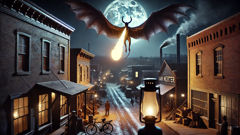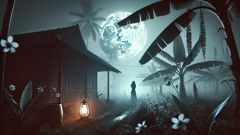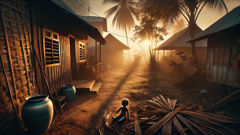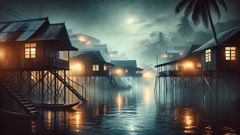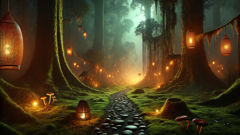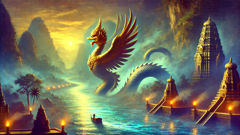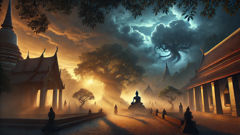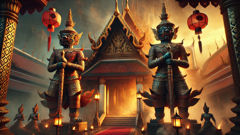Introduction
In the autumn of 1903, the tranquil farming town of Van Meter, Iowa, was roused from its slumber by a series of extraordinary events that would leave its name forever etched in American folklore. Nestled among endless fields of golden corn, Van Meter was the sort of place where doors were rarely locked, and neighbors trusted one another implicitly. But as the nights grew colder and the harvest moon cast long, shifting shadows across Main Street, a sense of unease began to settle over the community. Whispers spread of a strange beast stalking the darkened alleys—a creature so bizarre and fearsome that even the most skeptical townsfolk found themselves peering anxiously into the night.
It began as a flicker of light, a subtle glow moving through the haze above the deserted town square. Then came the shrieks—unearthly, metallic, neither bird nor beast. Those unlucky enough to glimpse the intruder described a monstrous silhouette gliding above the rooftops, its leathery wings spanning the width of a wagon, and atop its head, a horn that blazed with an eerie, otherworldly radiance. Some called it a demon; others swore it was a sign from God or the devil. For several nights, the "Van Meter Visitor," as it came to be known, visited terror upon the town, shattering the peace and drawing people together in fear, suspicion, and—eventually—unexpected bravery.
This is not a tale of fantasy spun for children around a campfire, nor is it a dry recitation of local history. This is the legend as it lives in the hearts of those who survived it: a richly detailed, immersive account that weaves together eyewitness testimony, local color, and the stubborn resilience of a community faced with the unknown. It’s a story of courage that rises in the shadow of fear, of neighborly bonds forged in crisis, and of a mystery that, over a century later, refuses to die. Step into Van Meter on those haunted autumn nights, when the line between reality and legend blurred, and discover what truly happened when the darkness came alive.
Nightfall and First Encounter
Van Meter in 1903 was a slice of rural Americana: dusty roads lined with gas lamps, the rhythmic clang of the blacksmith’s hammer by day, and at night, an enveloping quiet broken only by the distant bark of a dog. The townspeople were proud of their little slice of civilization, where progress came in the form of a new brickyard and the odd traveling salesman passing through on the Des Moines rail line. But as September waned, something altogether new arrived—a visitor who cared nothing for social order or human invention.
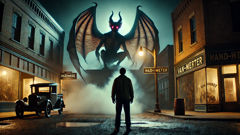
It began with U.G. Griffith, a respected businessman, returning late from work. He was hurrying past the old brickworks when he noticed a peculiar beam of light—strange, bluish, wavering in the mist—moving against the darkness above. At first, Griffith thought it a prankster with a lantern, but as he approached, the source revealed itself: an immense, winged shape perched atop the hardware store roof. Its skin gleamed dark and scaly, its eyes reflecting the gaslight like burning coals. Most striking of all was a horn on its head, pulsing with a bright, unnatural glow.
Frozen with fear, Griffith watched as the creature unfurled its wings—leathery and vast as a barn door—and leapt into the air, emitting a piercing shriek that echoed through the empty street. The light atop its horn swept across the storefronts as it soared over Main Street, vanishing into the night as swiftly as it appeared. By morning, rumors had begun to spread. Some dismissed Griffith’s account as exhaustion or a trick of the moonlight. But when Clarence Dunn, the local banker, discovered strange three-toed prints outside his window—each nearly a foot long—the skepticism began to wane.
The following night, Dr. Alvah Richards prepared for bed when a sudden clamor erupted from the alley behind his office. Armed with a revolver and curiosity, he crept outside. There, looming in the lamplight, was the creature again, its luminous horn bathing the alley in ghostly blue. Dr. Richards fired, the shots ringing out through the silent town. The bullets struck home, but the beast didn’t bleed or falter; instead, it recoiled with an angry roar and flapped away, the glow from its horn flickering like a dying star.
Word traveled quickly. By the third night, groups of men patrolled the streets, shotguns and pistols at the ready. Each sighting was more dramatic than the last. The beast was seen clawing at the door of the schoolhouse; it hovered outside the post office, peering in with burning eyes. At one point, it landed on the steeple of the Methodist church, casting an enormous shadow across the gravestones below. No one could agree on what it was—a prehistoric animal, a demon, or something conjured by the fevered mind of a town on edge. But none could deny its presence or the fear it inspired.
Panic and Pursuit
By the fourth night, Van Meter was gripped by fear. The townspeople, usually quick to dismiss the supernatural, found themselves huddled in their homes, doors locked and windows shuttered. Even the children, so often immune to adult anxieties, sensed the change—school lessons interrupted by nervous glances at the sky, whispers traded behind cupped hands. There was talk of calling in help from Des Moines, but no one could say exactly what to report: a beast, a ghost, or some new kind of madness.
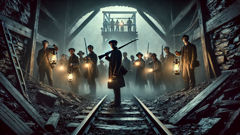
But Van Meter’s spirit was not so easily cowed. The town’s leading men—Griffith, Dunn, Dr. Richards, and local newspaper editor O.V. White—met at the pharmacy to plot their next move. White, eager for a story that would put his paper on the map, insisted on documenting every account in his notebook. The plan was simple: form patrols, lay traps, and if possible, capture or kill the creature that had so disturbed their peace.
On the fifth night, they stationed themselves at key points along Main Street, weapons at the ready. The air was thick with anticipation and the scent of gun oil. Midnight approached when a cry rang out near the brickyard. The men rushed to the scene to find the creature looming beside a stack of bricks, its horn glowing so brightly it cast long shadows across the ground. As they fired upon it in unison, the beast staggered, but again showed no sign of injury. Instead, it launched itself skyward with a powerful flap of its wings, showering the men with dust and broken brick.
But this time, there was a difference: a second creature appeared, smaller but otherwise identical, and together they soared above the rooftops, circling the town in a slow, ominous dance. The townsfolk watched in awe and dread as the pair glided toward an abandoned coal mine at the edge of town. There, they vanished into the darkness, their glowing horns marking the entrance like torches in a tomb.
The following day, White’s account appeared on the front page of the Van Meter newspaper. News spread beyond Iowa; telegrams arrived from Chicago and Kansas City, and curiosity-seekers began to trickle in on the morning train. But for Van Meter’s citizens, there was no thrill in their notoriety—only exhaustion and the grim determination to see an end to their ordeal.
The men resolved to confront the creatures in their lair. Armed with lanterns and every firearm they could muster, a posse gathered at dusk and marched toward the mine. The opening was jagged and black, the earth around it pitted with ancient footprints. They waited in silence as night fell, their nerves frayed and senses alert. Then, from within the mine, came a low, guttural rumble—the sound of something stirring in the deep.
The Final Stand and Enduring Mystery
The standoff at the mine was unlike anything Van Meter had ever known. The men—some seasoned hunters, others trembling with nerves—fanned out along the edge of the pit, their lanterns bobbing in the night air. They waited, hearts pounding, as a chill wind swept over the fields and carried with it the scent of damp earth and something unnameable.
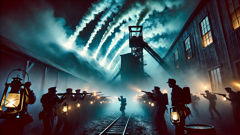
Suddenly, with a shriek that rattled windows a mile away, both creatures erupted from the mine. The larger one led, its horn blazing like a lighthouse, followed closely by its smaller companion. They soared into the sky, banking low over the crowd. Guns roared; shot after shot rang out, echoing down Main Street. The townsfolk watched as bullets struck the beasts’ leathery hides and ricocheted harmlessly away.
Panic threatened to take hold, but then something remarkable happened: as one, the men stood their ground. They formed a semicircle at the mine’s mouth, blocking any retreat. The creatures circled overhead, shrieking and diving, but the barrage of gunfire was relentless. After several tense minutes, the beasts seemed to falter. With one final, echoing cry, they plunged back into the mine and vanished into the earth.
The men stood in stunned silence, their weapons smoking, as the echo of those cries faded into the hills. No one dared pursue them underground. Instead, they piled rocks and timbers over the entrance, sealing it shut. The town waited through a long, restless night, but the creatures did not return.
Morning brought a strange calm. The mysterious prints had vanished. The air no longer thrummed with tension. For the first time in a week, life in Van Meter began to resume its normal rhythms. Yet something had changed forever. The story of the Van Meter Visitor spread far beyond Iowa, whispered from farmstead to farmhouse and retold in towns across the Midwest. Some dismissed it as mass hysteria or an elaborate hoax. Others believed the creatures were ancient survivors, awakened from eons of sleep by the clamor of civilization. Still others insisted they were spirits—guardians or omens—sent to test the courage of humankind.
Years passed. The mine was eventually filled in and forgotten. Yet on clear autumn nights, when the moon is full and fog curls along the Des Moines River, children still gather on porch steps to trade tales of the winged beast with the glowing horn. And every so often, an old-timer swears he’s seen a flicker of blue light moving through the cornfields or heard an unearthly shriek in the dark.
Conclusion
The legend of the Van Meter Visitor has endured for more than a century because it touches something primal in all who hear it: a fear of the unknown, yes, but also a reminder that courage is not the absence of fear but its defiant companion. The people of Van Meter did not let panic divide them; instead, they faced the darkness together, relying on one another when reason and certainty failed. Whether the creature was real or imagined is, in some ways, beside the point. What matters is the bond it forged among neighbors, the stories shared across generations, and the quiet heroism that rises when ordinary lives are interrupted by the extraordinary. Today, Van Meter embraces its mysterious past—a past where a small town stood firm against the shadows and found its place in the annals of American legend.

